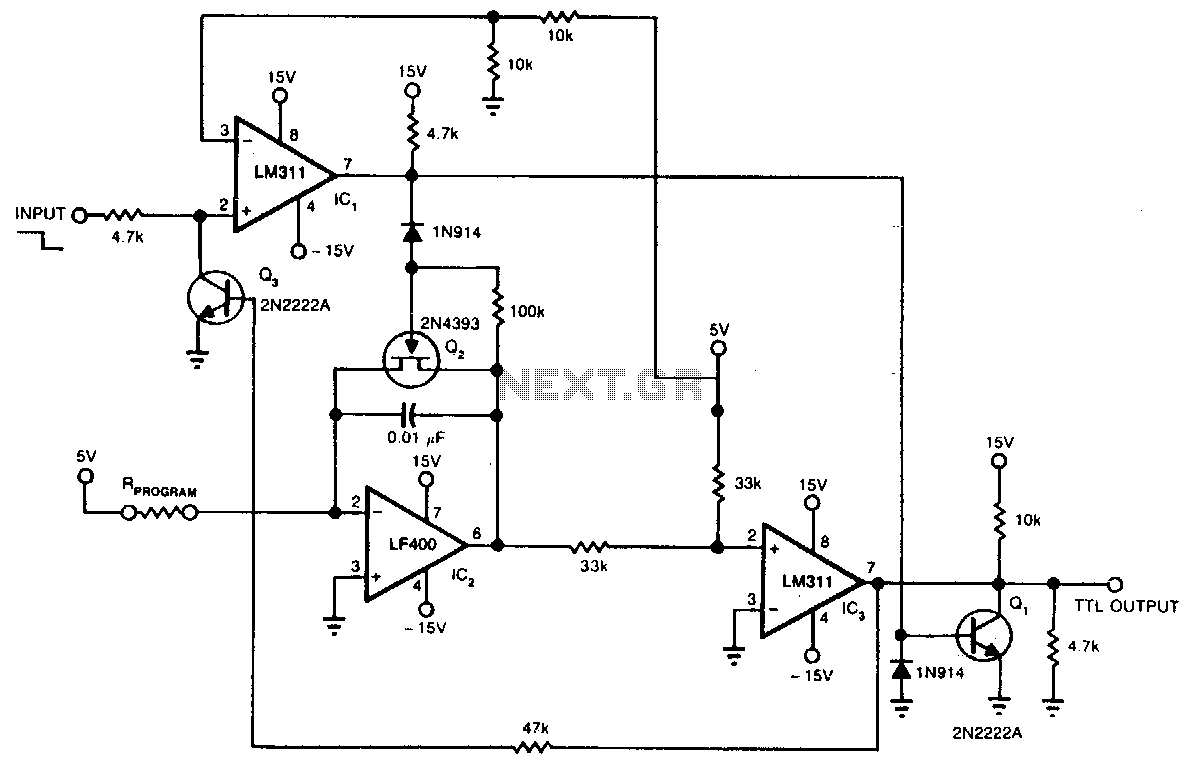
Precision-one-shot

A wide-range, resistor-programmable monostable multivibrator can be configured for pulse widths ranging from 1 µs to 10 s, providing a 107:1 range. A high-to-low transition at the input causes the output of IC1 to switch low, which turns off transistors Q1 and Q2. With Q2 turned off, the output of IC3 increases, while the output of IC2 begins to ramp down toward the negative supply level at a rate determined by a 0.01 µF capacitor and the programming resistor. When the output voltage of IC2 reaches -5 V, the output of IC3 switches low. If shorter input pulses are anticipated than the desired output pulses, transistor Q3 is required. This transistor maintains IC1's input low while an output pulse is present, thus preventing inadvertent resetting of the monostable multivibrator.
The described circuit utilizes a monostable multivibrator configuration, which is ideal for generating precise pulse widths based on external programming components. The key integrated circuits (ICs) involved in this design include IC1, IC2, and IC3, each serving specific roles in the pulse generation and control process.
IC1 functions as the monostable multivibrator, responding to input transitions. When a high-to-low transition occurs, IC1's output goes low, which deactivates both Q1 and Q2. Q1 and Q2 are likely used for output signal control, where their deactivation is essential for the subsequent actions of IC2 and IC3.
IC2 is configured with a timing capacitor (0.01 µF) and a programming resistor, which together determine the ramping behavior of its output voltage. The ramping down of IC2's output toward the negative supply level is a critical aspect of the timing sequence, as it defines the duration of the output pulse generated by the multivibrator.
IC3 monitors the output of IC2. Once IC2's output voltage drops to -5 V, IC3 switches low, which could be used for further signal processing or as a trigger for additional circuitry. The inclusion of transistor Q3 is significant for applications where input pulse lengths may vary. By keeping IC1's input low during the duration of the output pulse, Q3 effectively prevents any unintended resets of the monostable multivibrator, ensuring reliable operation even in the presence of shorter input pulses.
Overall, this monostable multivibrator circuit is versatile and can be tailored for various applications requiring precise pulse width modulation. The combination of resistor programmability and the defined timing characteristics make it suitable for use in timing applications, signal generation, and other electronic control systems.If you need a wide-range, resistor-programmable monostable multivibrator, you can program tbe circuit for pulse widths from 1 JlS to 10s-107:1 range. A high-to-low transition at tbe input causes IC1"s output to switch low, thereby turning off Q1 and Q2.
With tbe latter transistor turned off, IC3"s output increases and tbe output ofIC2 begins to ramp toward tbe negative supply level at a rate determined by the 0.01-JlF capacitor and tbe programming resistor. When IC2"s output voltagereaches -5 V, IC3"s output switches low. Ifyou anticipate input pulses shorter than tbe desired output pulses, Q3 is necessary. This transistor keeps IC1s input low while an output pulse is present, thereby preventing inadvertent resetting of tbe one shot. 🔗 External reference
The described circuit utilizes a monostable multivibrator configuration, which is ideal for generating precise pulse widths based on external programming components. The key integrated circuits (ICs) involved in this design include IC1, IC2, and IC3, each serving specific roles in the pulse generation and control process.
IC1 functions as the monostable multivibrator, responding to input transitions. When a high-to-low transition occurs, IC1's output goes low, which deactivates both Q1 and Q2. Q1 and Q2 are likely used for output signal control, where their deactivation is essential for the subsequent actions of IC2 and IC3.
IC2 is configured with a timing capacitor (0.01 µF) and a programming resistor, which together determine the ramping behavior of its output voltage. The ramping down of IC2's output toward the negative supply level is a critical aspect of the timing sequence, as it defines the duration of the output pulse generated by the multivibrator.
IC3 monitors the output of IC2. Once IC2's output voltage drops to -5 V, IC3 switches low, which could be used for further signal processing or as a trigger for additional circuitry. The inclusion of transistor Q3 is significant for applications where input pulse lengths may vary. By keeping IC1's input low during the duration of the output pulse, Q3 effectively prevents any unintended resets of the monostable multivibrator, ensuring reliable operation even in the presence of shorter input pulses.
Overall, this monostable multivibrator circuit is versatile and can be tailored for various applications requiring precise pulse width modulation. The combination of resistor programmability and the defined timing characteristics make it suitable for use in timing applications, signal generation, and other electronic control systems.If you need a wide-range, resistor-programmable monostable multivibrator, you can program tbe circuit for pulse widths from 1 JlS to 10s-107:1 range. A high-to-low transition at tbe input causes IC1"s output to switch low, thereby turning off Q1 and Q2.
With tbe latter transistor turned off, IC3"s output increases and tbe output ofIC2 begins to ramp toward tbe negative supply level at a rate determined by the 0.01-JlF capacitor and tbe programming resistor. When IC2"s output voltagereaches -5 V, IC3"s output switches low. Ifyou anticipate input pulses shorter than tbe desired output pulses, Q3 is necessary. This transistor keeps IC1s input low while an output pulse is present, thereby preventing inadvertent resetting of tbe one shot. 🔗 External reference
Warning: include(partials/cookie-banner.php): Failed to open stream: Permission denied in /var/www/html/nextgr/view-circuit.php on line 713
Warning: include(): Failed opening 'partials/cookie-banner.php' for inclusion (include_path='.:/usr/share/php') in /var/www/html/nextgr/view-circuit.php on line 713